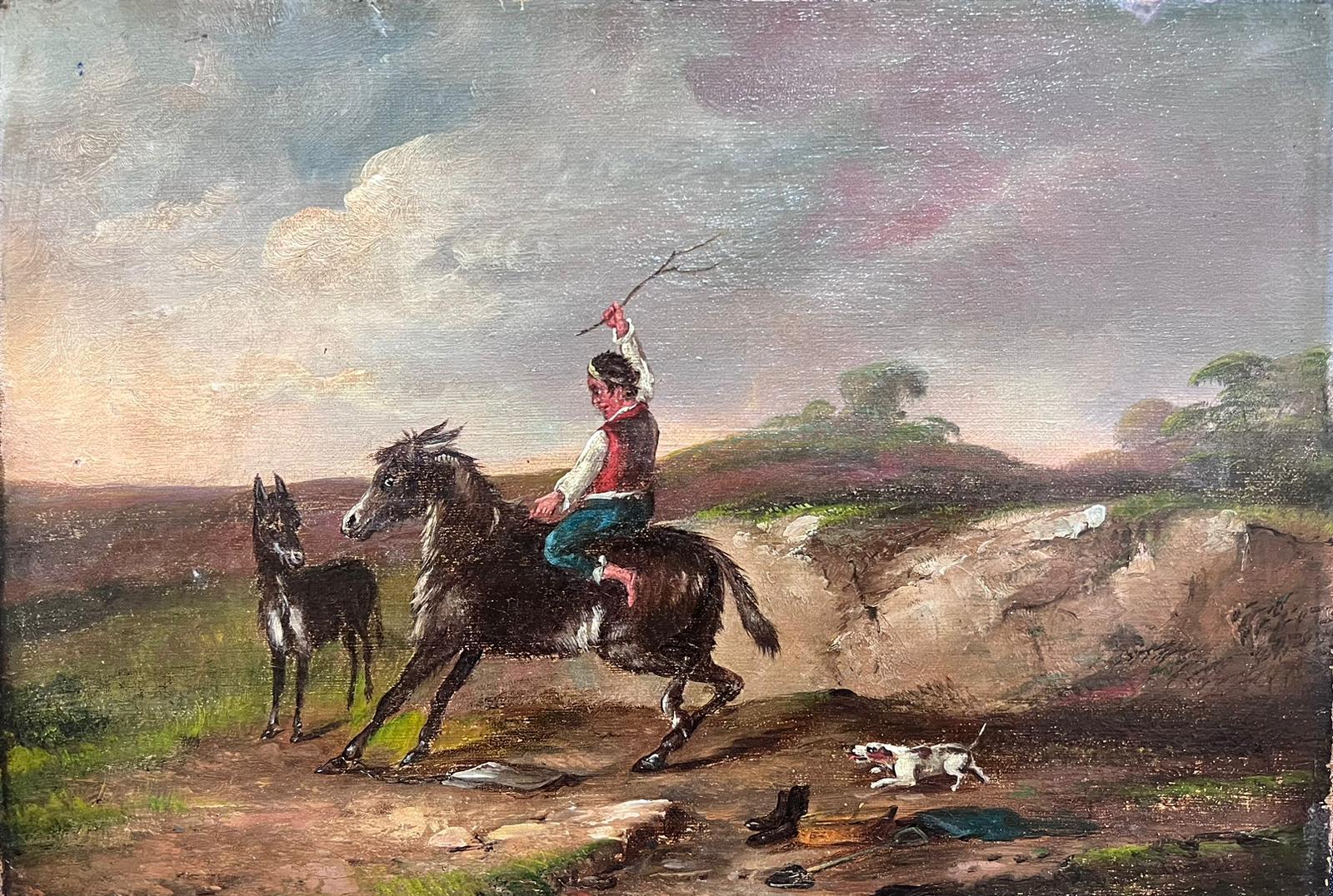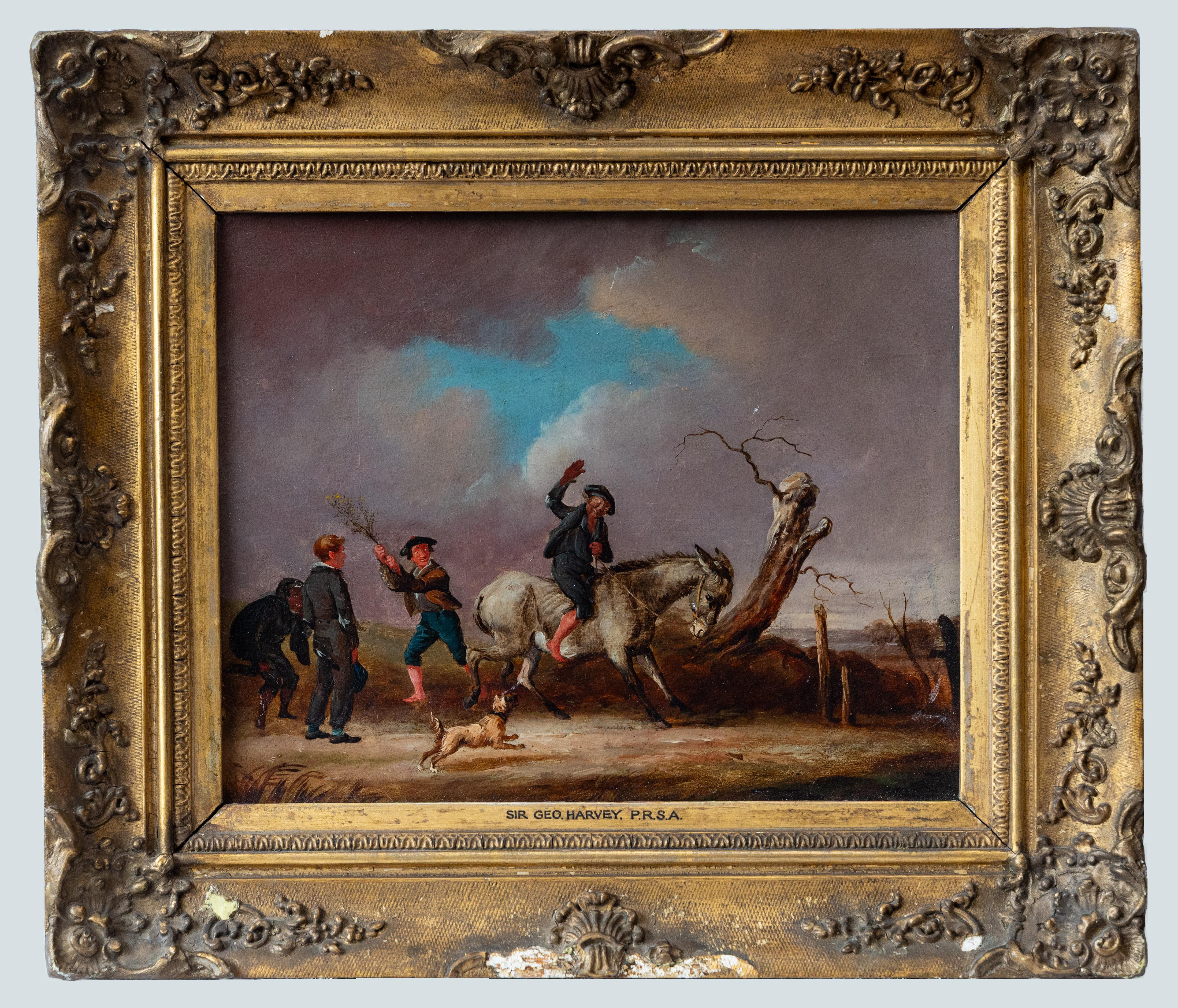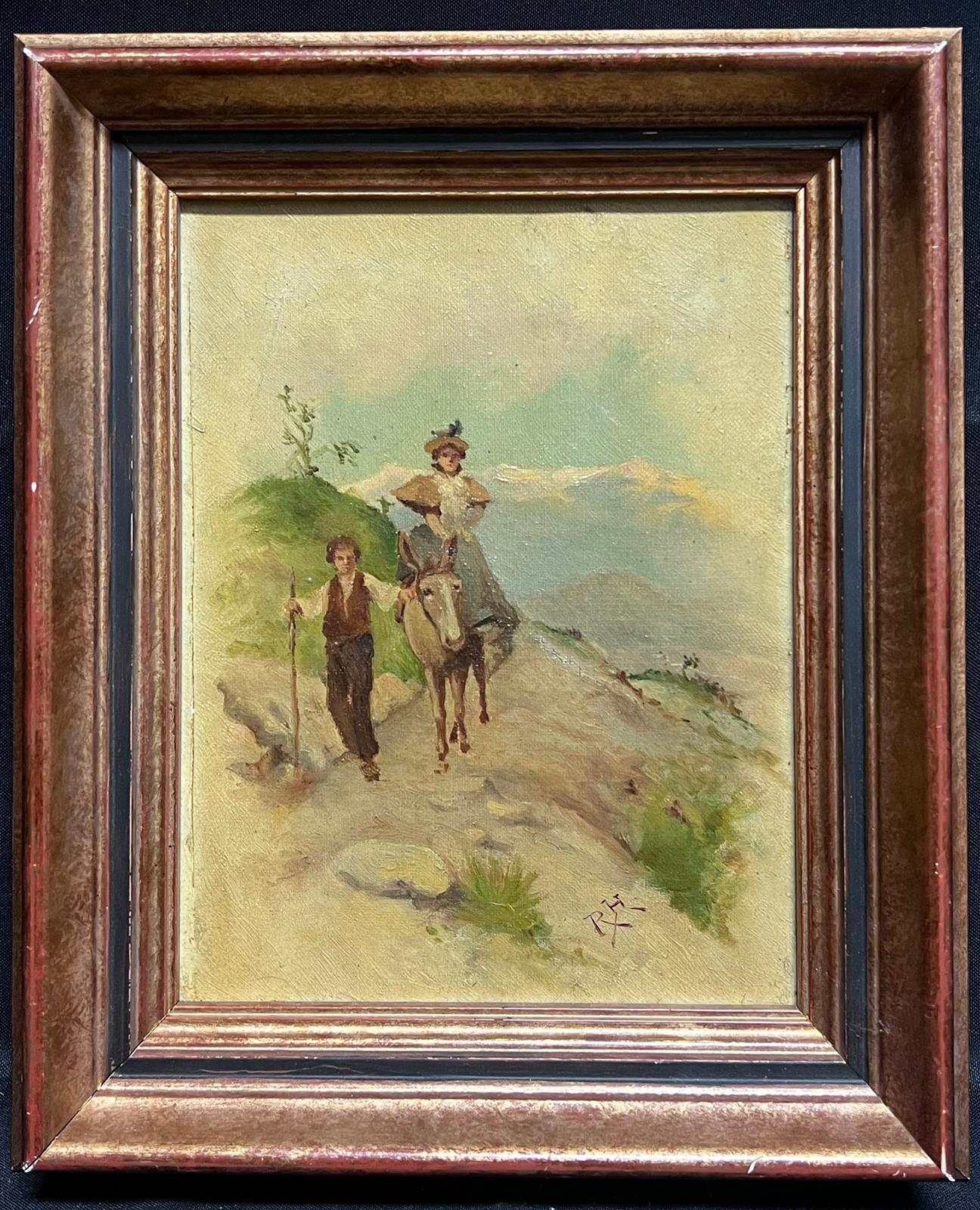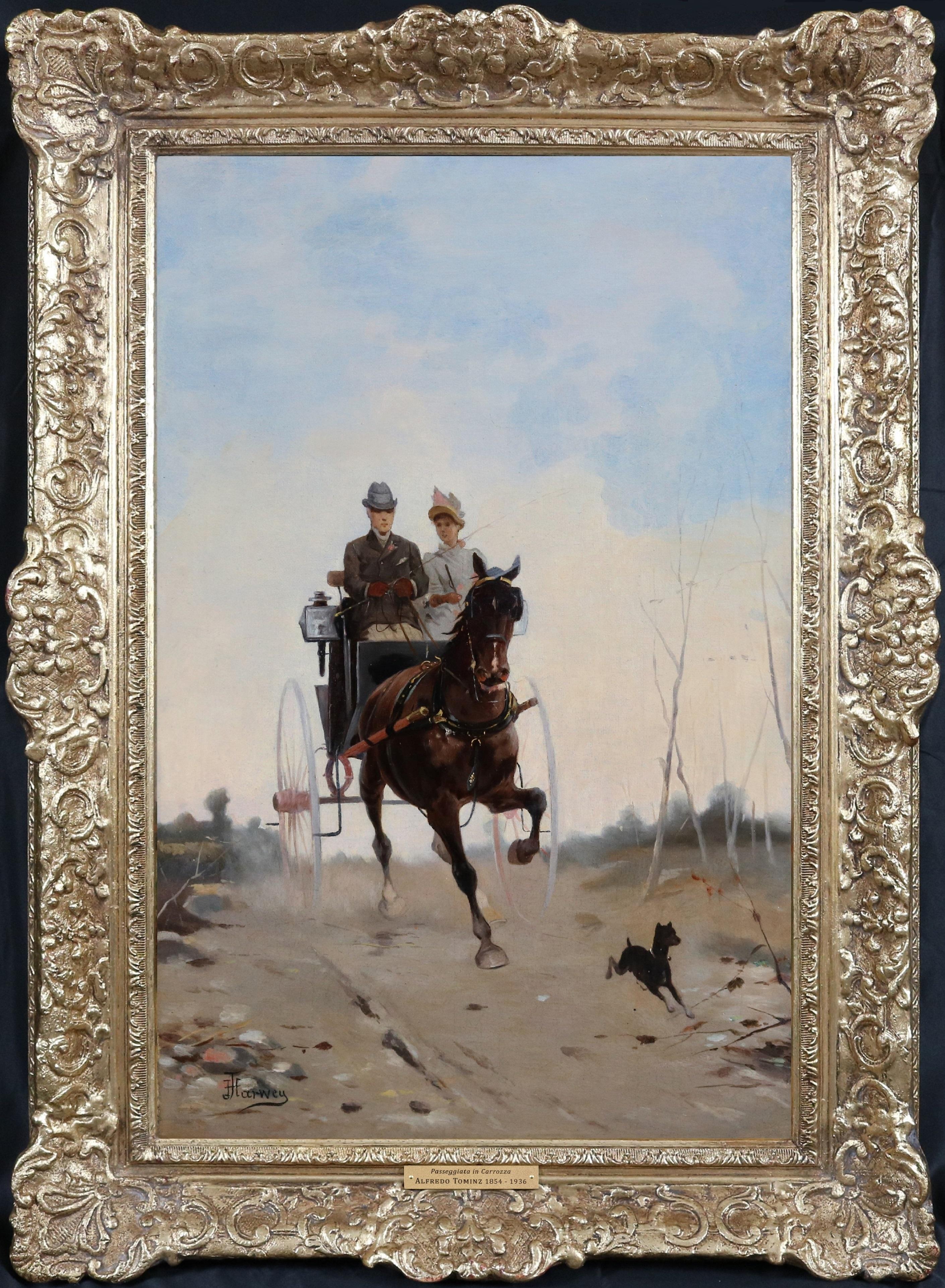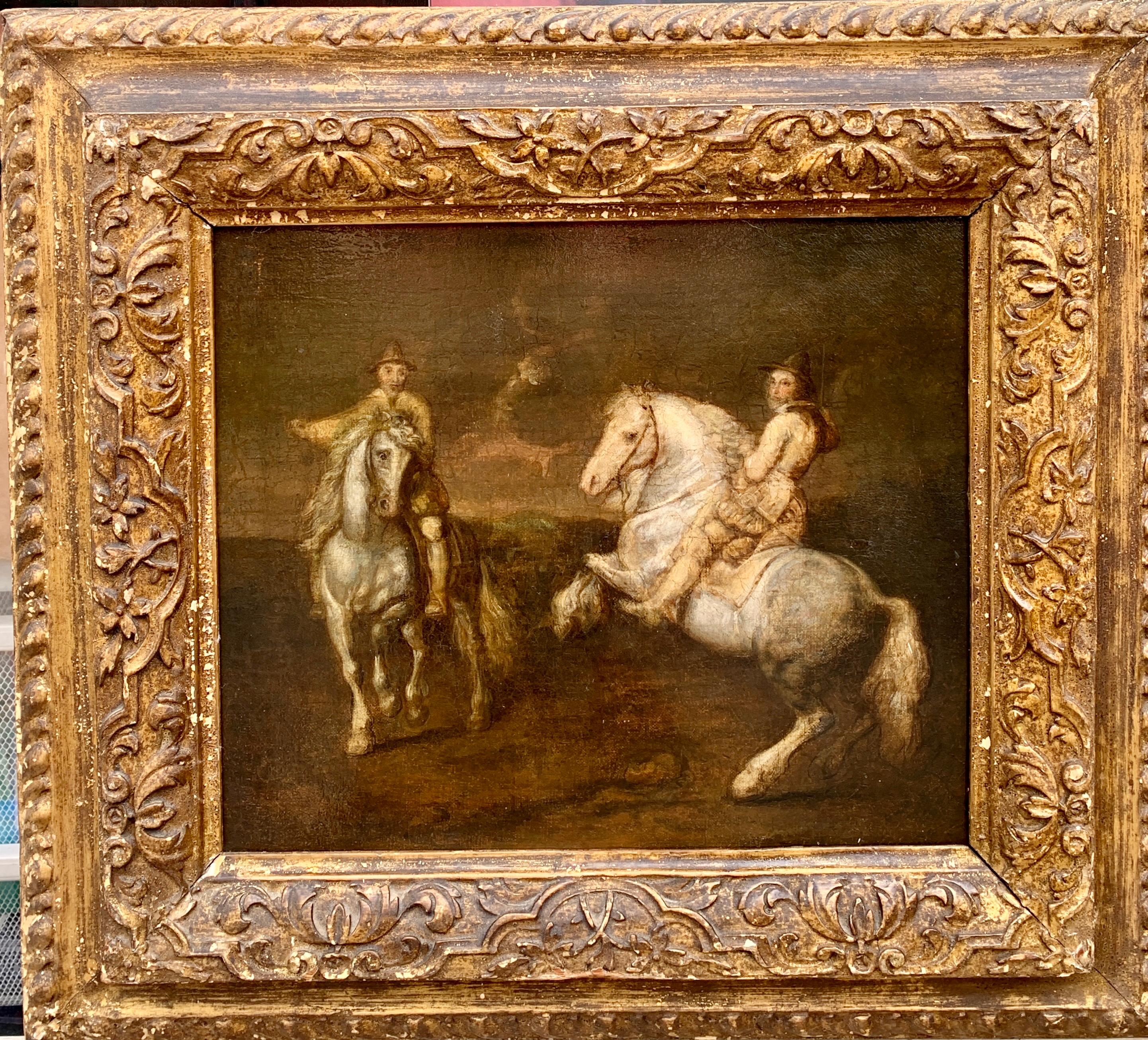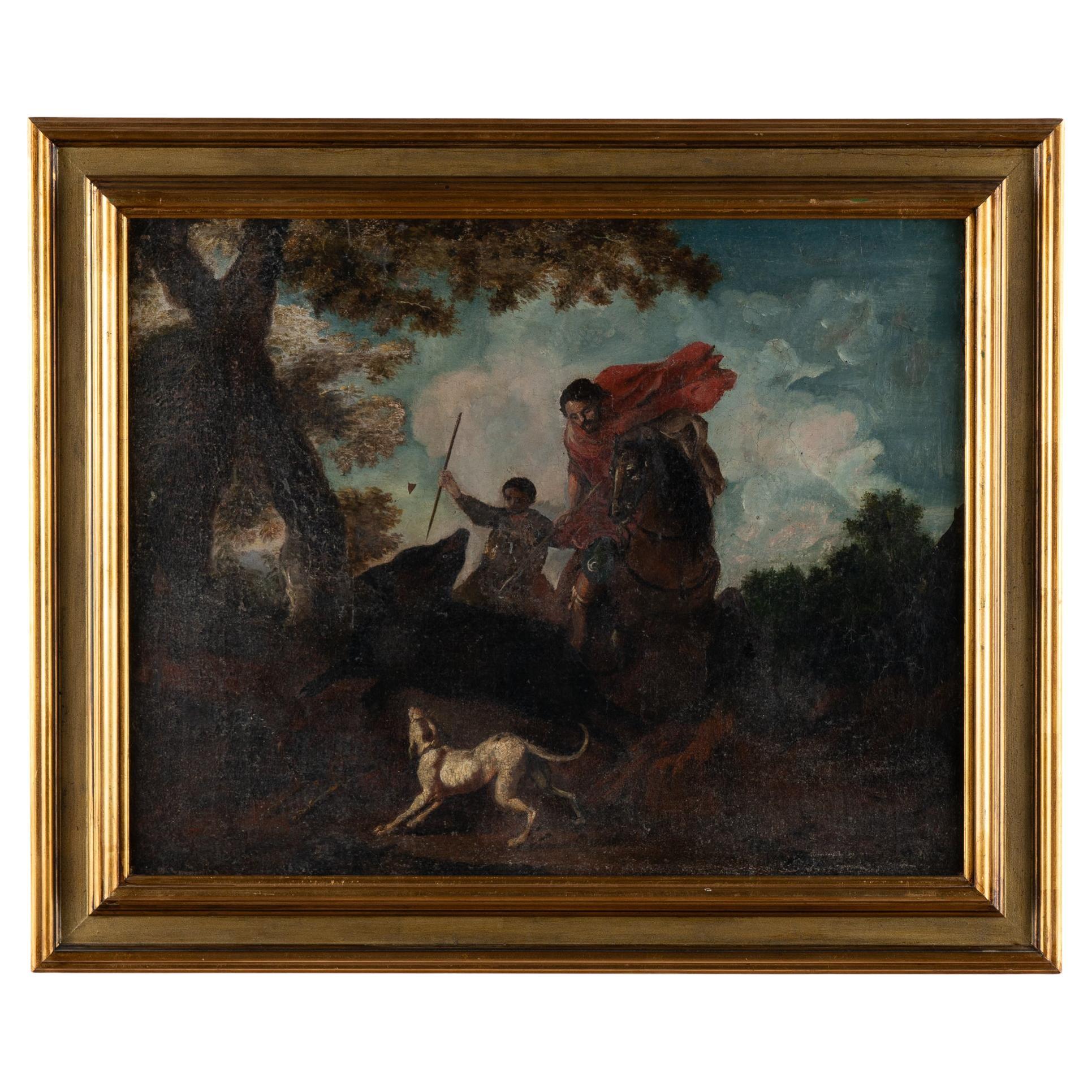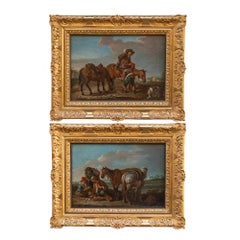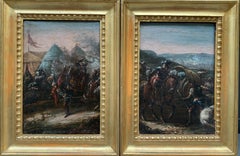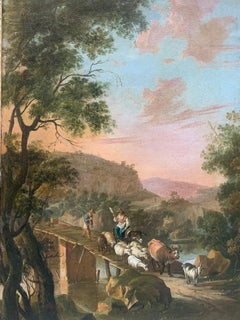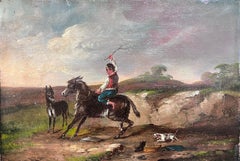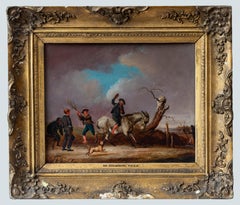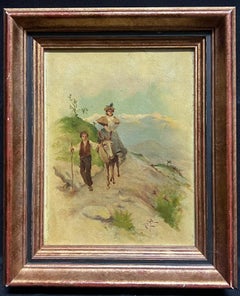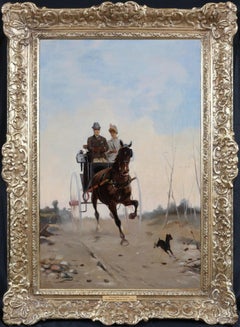Items Similar to The Runaways, or Swiss boy on Donkey. Attributed to Joseph Hornung.
Want more images or videos?
Request additional images or videos from the seller
1 of 20
The Runaways, or Swiss boy on Donkey. Attributed to Joseph Hornung.
$686.19
$1,151.4940% Off
£523.77
£878.9340% Off
€584
€98040% Off
CA$967.91
CA$1,624.2340% Off
A$1,063.21
A$1,784.1540% Off
CHF 555.64
CHF 932.4140% Off
MX$12,679.63
MX$21,277.4540% Off
NOK 7,035.89
NOK 11,806.8040% Off
SEK 6,554.52
SEK 10,999.0340% Off
DKK 4,451.20
DKK 7,469.4840% Off
About the Item
A couple of young boy and girl, dressed in ethnographic costumes, probably Savoyard, ride a donkey.
The scene takes place in the middle of the countryside with mountains in the background.
Style: romanticism.
Technique: oil on panel, with applications of cotton canvas on the back, to strengthen the wooden panel structure.
The particular way of placing brushstrokes, picturesque and slightly bizarre and expressive, probably has origins in the pictorial movement that starts from Delacroix, from his romantic representations of the East and of scenes that express freedom, exoticism, curiously describing ethnographic and somewhat idealized characters of different countries.
The painter skillfully manages to convey a particular atmosphere by painting the clouds in dynamic movement, thus creating the emotional effect.
Biografical notices on painter.
Joseph Hornung (1792 Geneva - 1870 Geneva).
Swiss artist of Alsatian origins.
One of the major representatives of the Geneva School, considered at the time the official painter of the Reformation.
After his apprenticeship as a watch case engraver, Joseph Hornung worked in this field before training himself in painting, although he studied drawing with Constant Vaucher.
Author of genre and historical paintings, he particularly favored themes linked to the history of Savoy and the Reformation (for example Les adieux de Calvin, 1829). He also created portraits (Guillaume Henri Dufour, Alexandre Vinet, Jean Humbert), landscapes and drawings.
From 1826 he exhibited successfully at the Paris Salons. His proposals at the Royal Academy in London (1839) or at the Paris Salon (in 1831, 1840, 1841, 1843 and 1847) earned him medals and laudatory mentions in the press, including those of the famous Étienne-Jean Delécluze.
His admirers included french King Louis Philippe and the painter Ary Scheffer.
However, he refused to settle in Paris and engaged in public life in Geneva.
He traveled to Italy (1834), Holland (1838) and England (1840 and 1859).
Hornung was a member of the Geneva cantonal legislature from 1836 (Representative Council, from 1842 Grand Council).
In friendship with the sculptors James Pradier and John-Étienne Chaponnière, the painters François Diday and Alexandre Calame, the writers John Petit-Senn, Marc Debrit and Marc Monnier, Hornung will become a legendary figure in the Geneva cultural world and his beard will delight the caricaturists.
Henri-Frédéric Amiel, who recorded their conversations in his diary, noted his erudition and nicknamed him “Pope Titian”. As Philippe Plan writes in one of the numerous obituaries dedicated to him, "there is no Genevan who had the honor of more biographical articles during his life".
The numerous portraits of him, including that of his wife or local celebrities such as General Dufour, Alexandre Vinet or Pastor Fazy, were also very successful. His historical subjects testify to his interest in the Reformation and Geneva's past, particularly Calvin's Farewells, Servetus Marching to Execution (1845), Froment's Preaching to Molard (1864) and Luther in the Cemetery of Worms. His masterpiece, The Day After Saint-Barthélemy, painted in 1852 for the Marquis Girolamo d'Adda, aroused critical enthusiasm.
He often made lithographic reproductions of his own paintings.
Works in the Museum: Geneva, Museum of Art and History; Lausanne, Cantonal Museum of Fine Arts; Lausanne, Historical Museum.
- Attributed to:Joseph Hornung (1792 - 1870, Swiss)
- Dimensions:Height: 17.52 in (44.5 cm)Width: 14.57 in (37 cm)Depth: 1.78 in (4.5 cm)
- Medium:
- Movement & Style:
- Period:
- Condition:
- Gallery Location:Firenze, IT
- Reference Number:1stDibs: LU2464213568842
About the Seller
4.9
Vetted Professional Seller
Every seller passes strict standards for authenticity and reliability
Established in 2016
1stDibs seller since 2023
86 sales on 1stDibs
Typical response time: 4 hours
- ShippingRetrieving quote...Shipping from: Firenze, Italy
- Return Policy
More From This Seller
View AllBamboccianti Countryside Scenes with Horses and Card Players, Rome circa 1740
Located in Firenze, IT
Countryside Scenes with Horses and Card Players, Rome circa 1740
Pair of Paintings: Countryside Halt with Horses & Card Game in the Countryside
Paolo Monaldi (post 1710 - post 1779),...
Category
Mid-18th Century Italian School Landscape Paintings
Materials
Canvas, Oil
Military Camp Scene and Battle. Pietro Graziani (XVII/XVIII century), entourage
Located in Firenze, IT
Military Camp Scene and Battle.
Pietro Graziani (XVII/XVIII century), entourage.
A pair ( two) of small paintings.
Antique XIX century frames in gilt wood.
In good condition.
Oi...
Category
Early 18th Century Old Masters Landscape Paintings
Materials
Canvas, Oil
$2,500 Sale Price
39% Off
Free Shipping
Landscape With Hunters By A Lake. 18th Century.
Located in Firenze, IT
Landscape with hunters by a lake.
18th century.
Oil painting on canvas, from the French or Northern Italian school, Louis XV period.
Probably part of the door decoration in an interi...
Category
18th Century Baroque Landscape Paintings
Materials
Canvas, Oil
$798 Sale Price
20% Off
Scope of Jan Both ( Utrecht, 1618-1652) Latial landscape with bridge and shepherds
Located in Firenze, IT
Italian landscape with a bridge, tower, shepherd and animals.
Scope of Jan Both ( Utrecht, 1618-1652), arrival in Rome and Venice in addition to his native Holland.
The 17th-century...
Category
17th Century Dutch School Landscape Paintings
Materials
Canvas, Oil
$2,819 Sale Price
36% Off
Achilles riding the Centaur Chiron by Marco Silombria. Signed by artist.
Located in Firenze, IT
Achilles riding the Centaur Chiron by Marco Silombria.
Hand signed by artist.
Created by Italian Pop - Art artist Marco Silombria ( Savona, 1936-Albissola, 2017).
The young boy, s...
Category
Early 2000s Pop Art Nude Paintings
Materials
Paper, Wax Crayon, Carbon Pencil, Color Pencil
$423 Sale Price
40% Off
Free Shipping
Venice. XVI century. Madonna with child with St. John. Attrib. Marco Bello.
Located in Firenze, IT
Sacred Conversation: Madonna with child with St. John with idealized landscape background with mountains.
Early XVI century.
Oil on wooden panel of Venetian conifers.
Marco Bello, attributed. (Venezia, 1470 - 1523, Udine), pupil and follower of Giovanni Bellini.
Venetian school.
Madonna with child with St. John with idealized landscape background with mountains.
Dimentions: 57cm x 68cm x 6cm
Beautiful late Renaissance frame...
Category
16th Century Renaissance Figurative Paintings
Materials
Wood Panel, Oil
You May Also Like
Antique 19th Century Italian Oil Painting Man riding Pony Horse in Landscape
Located in Cirencester, Gloucestershire
The Stubborn Mule
Italian School, 19th century
oil on canvas, unframed
canvas: 9.75 x 14 inches
provenance: private collection
condition: very good and sound condition, a little scru...
Category
Mid-20th Century Modern Landscape Paintings
Materials
Oil, Canvas
Children playing with a donkey
By George Harvey
Located in GB
Sir George Harvey was a prominent Scottish painter, born on 1 February 1806 in St Ninians (now Stirling), the son of a watchmaker. Although he initially apprenticed as a bookseller i...
Category
19th Century English School Figurative Paintings
Materials
Oil, Board
Figures Mountainside Pass Riding a Donkey Signed Antique Italian Oil Painting
Located in Cirencester, Gloucestershire
The Mountain Pass
Italian School, 19th century
signed initials oil on canvas, framed
framed: 13 x 11 inches
canvas: 10 x 7.5 inches
provenance: private collection, France
condition: ...
Category
19th Century Victorian Figurative Paintings
Materials
Oil
Passegiato in Carrozza- 19th Century Italian Oil Painting Horse & Society Couple
Located in Gerrards Cross, GB
‘Passeggiata in Carrozza’ by Alfredo Tominz (1854-1936)
The painting – which depicts an elegant couple in a gig with their Miniature Pinscher running ahead – is signed by the artist...
Category
Late 19th Century Italian School Figurative Paintings
Materials
Oil
17th century follower of Rubens, two military men on horse back in a landscape
Located in Woodbury, CT
17th century English/Dutch School, from the Circle of Sir Peter Paul Rubens
A very interesting and well-painted 17th-century oil on canvas of two men seated on horseback in a landsc...
Category
1680s Old Masters Figurative Paintings
Materials
Canvas, Oil
$6,900 Sale Price
40% Off
Free Shipping
Original Oil on Canvas Painting of Hunter on Horseback, Italy circa 1760-80
Located in Round Top, TX
Original oil on canvas painting of hunter on horseback.
Condition: duplicate canvas, refurbished, stains, retouches, some paint loss (see close up photos). Age related craquelure thr...
Category
Antique Late 18th Century Italian Paintings
Materials
Canvas, Wood, Paint
More Ways To Browse
Donkey Antique
19th Century Portrait Of Young Boy
Dress Boy
19th Century Dutch Romantic Oil Paintings
Antique Reproduction Paintings
Antique Cloud Painting
Alexandre Calame
Engrave A Watch
Francois Diday
Senegal Art
Trapeze Artist
Western Cowboy Painting
Adam And Eve Oil Painting
Bar Scene Painting
Contemporary Religious Art
Holocaust Survivor
Men Dancing
Mother Daughter Paintings
